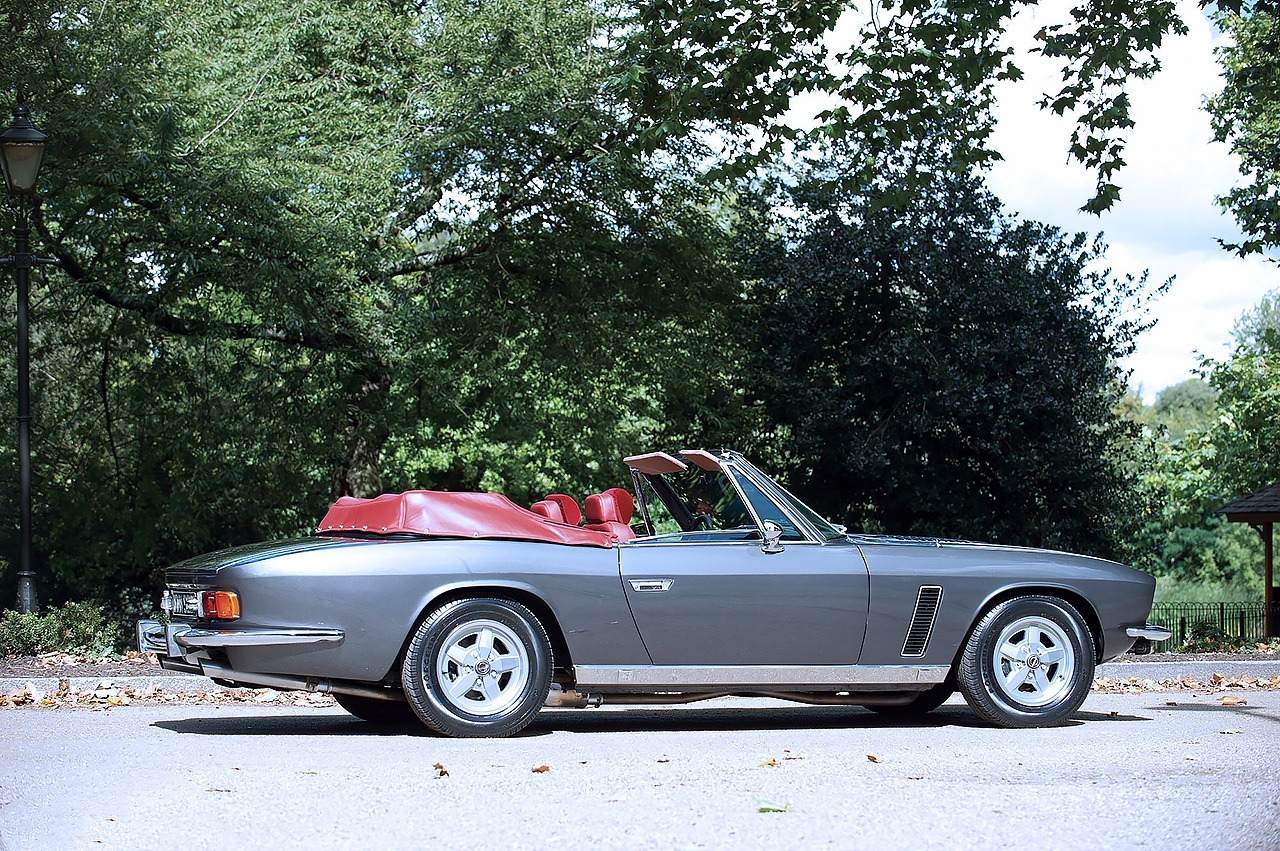
Jensen Interceptor III Convertible 7.2 road test. Seven litres of relaxed open-air motoring — the Jensen Interceptor III convertible in its best guise, with the top down. Convertible version of Jensen’s familiar Interceptor. Excellent performance, steering and brakes as before; thirsty. Rather noisy. Most pleasing with hood down. Expensive.
Contrary to what, seemingly, every American and some British car manufacturers appear to have assumed, the convertible-top car is neither outlawed by safety regulations, nor unwanted by customers. There are, of course, a number of open sports-cars, mostly British, but nowadays very few open four-seaters of medium size, and only two luxury open tourers with room for four (now that there are no big American convertibles). One of these is the Rolls-Royce (or Bentley) Comiche convertible (£16,343), and the other the subject of this Road Test, Jensen’s Interceptor Convertible, announced early this year (1974), and priced at the figure of £9,863 (1974 all new).
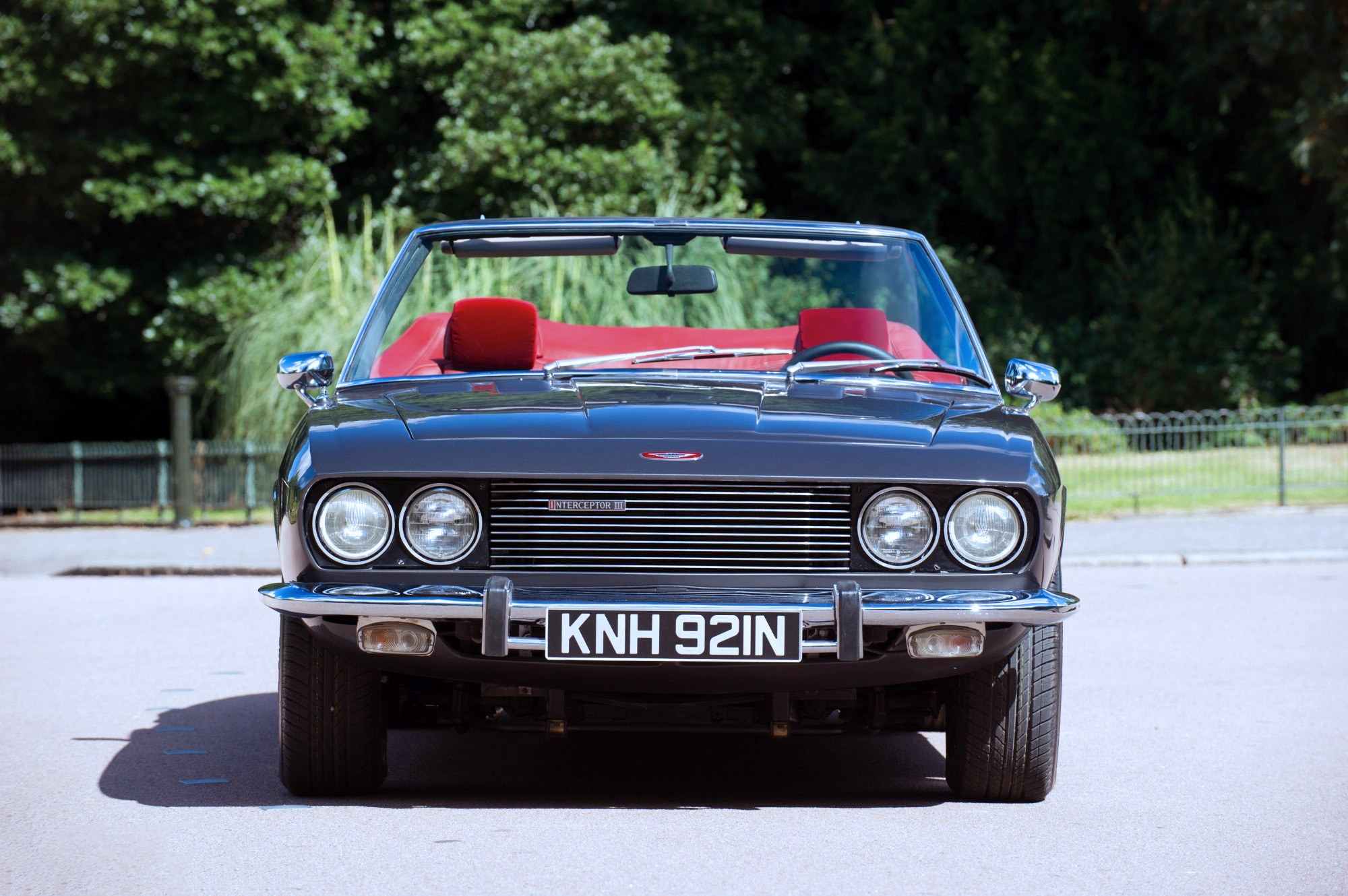
It is, of course, based on the running gear and floor pan of the familiar Vignale-bodied Interceptor III fixed-head coupe. Without recourse to anyone in Italy, Jensen have re-bodied the car (to most eyes) very elegantly indeed, with an attractive slim tail, and a traditional fabric folding roof, with power raising and lowering – and traditionally bad over-the-shoulder vision.
The engine and three-speed automatic transmission are both Chrysler as before, except that the engine is equipped with most (not all) of the modifications introduced in its native country to meet exhaust and evaporative emission regulations.
Remembering that, it is pleasant to be able to say that on the test car there were few of the usual signs of an emission-controlled engine in driveability, apart from a reluctance to fire on automatic choke when cold.
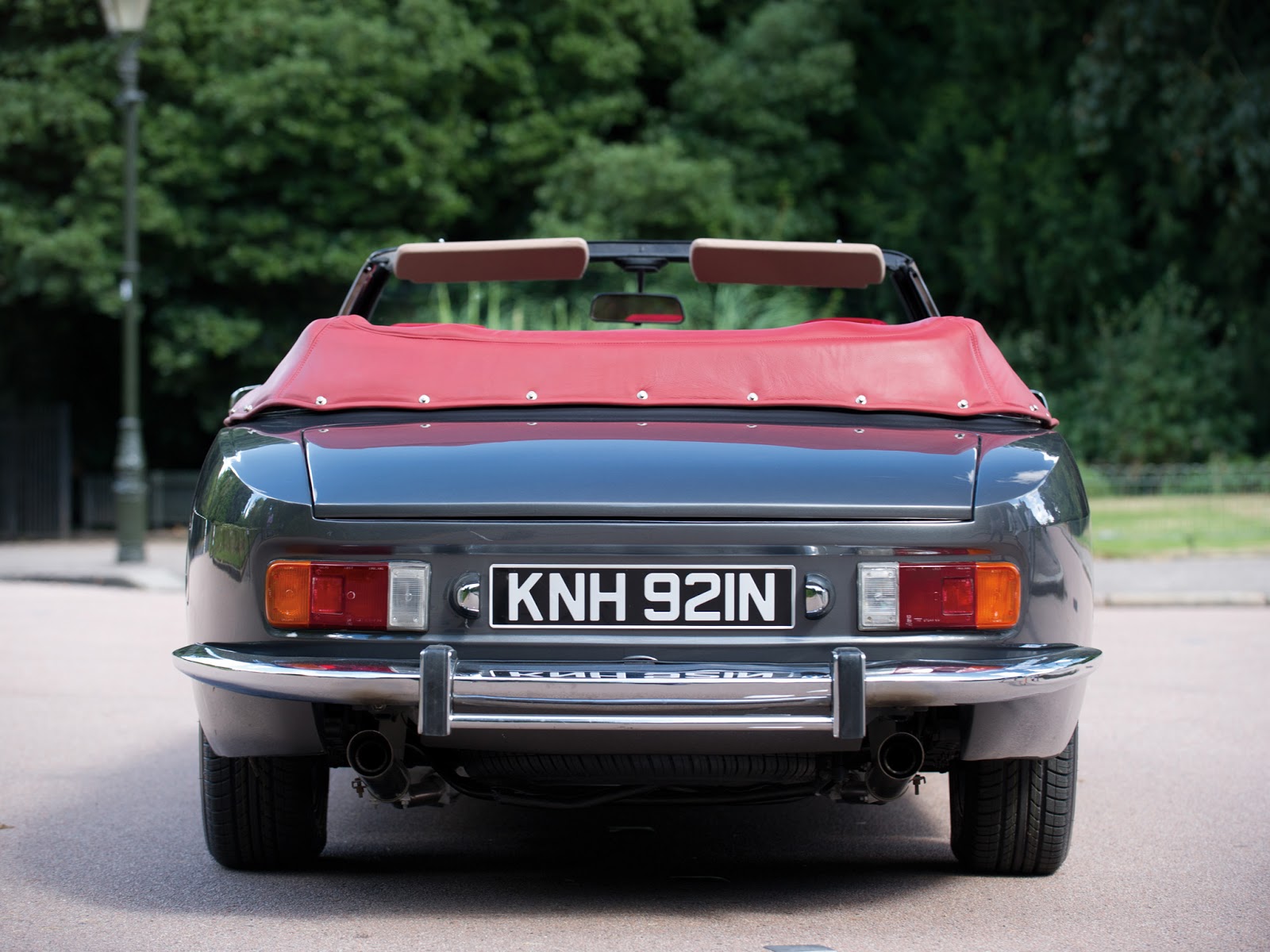
Car’s external appearance is not spoiled when hood is erected, but over-the-shoulder poor. There is a refreshing lack of unnecessary decoration.
The V8 power unit is markedly over-square at 109.72mm x 95.25mm bore and stroke, giving a total swept volume of 7,212 c.c. It has hydraulic tappets, a central camshaft, a five-bearing crankshaft, a four-choke Carter carburettor, and an 8.2-to-1 compression ratio. It runs satisfactorily on two-star fuel, of which it uses plenty (see below). To some extent the test car’s thirst must be due to the fact that it used the lower of the two final drive ratios offered, 3.07-to-1 instead of 2.88-to-1, corresponding (assuming no torque converter slip) to maximum overall gearing of only 24.8 mph per 1,000rpm, instead of the more preferable 26.4mph per 1,000rpm. The unit’s claimed peak power of 280bhp (net) occurs at 4,400 rpm, so that the car as delivered proved to be geared down, top speed being limited by the maximum allowed engine speed of 5,100 rpm. Observing the red line at 5,100 rpm on the rev-counter corresponded to 123 mph, though if, as is usually the case at maximum, torque converter slip is negligible, top speed is actually 126 mph (the rev-counter over-reading by 2 3/4 per cent).
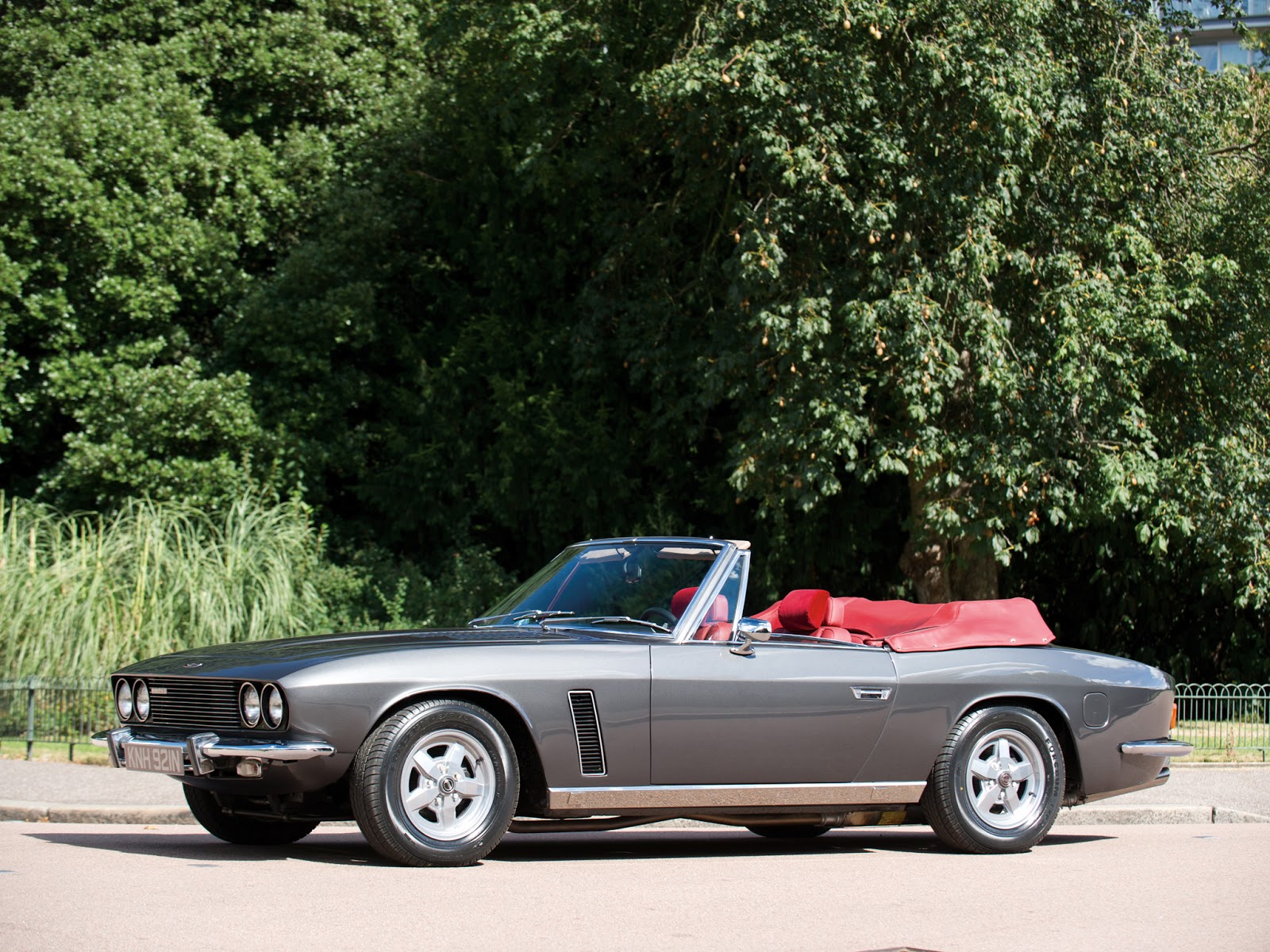
Hood under its cover sits on rather than in the neat tail.
The test car was rather short of mileage when delivered, arid performance figures had to be taken with only 2,300 miles on the distance recorder. This only partly explains the performance figures, which, though more than adequate for most people, are not quite as good as any previous Interceptor we have tested. No doubt measures taken to meet American regulations are another reason why this 7.2-litre Interceptor takes over 1sec more to reach 60 mph, and 2sec longer to reach 100 mph, than the 6.3-litre tested in 1969 – though that car did not have air-conditioning. Weight is also in the earlier car’s favour, the convertible turning the scales at 35.7cwt in kerb condition, compared with 33cwt of the former.

Nevertheless, acceleration is pretty vivid for the size of car. The Chrysler Torqueflite transmission is ideally ratioed for the job, changing up flat-out at 4,400 rpm, and road speeds of 44 and 74 mph. We tried holding the changes to higher speeds, but only at 4,700 rpm indicated was there a tiny improvement (0.2sec in the 100 mph time). Holding the car momentarily on the brakes against full throttle, then letting go, there was a brief flurry of wheelspin before it swept up to 50 mph in 5.5sec, 60 in 7.6, 80 in 12.5, the quarter-mile in 15.8, 100 in 20.2, and 120 in 35sec, all comfortably within the mile. Gearchanges are noticeable when driven thus, but with gentler driving are fairly unobtrusive. Kick-down response is good, so that one is not dependent on the selector lever for that extra bit of urge which makes overtaking so much safer in this sort of car; such changes are on the jerky side by the. standards of a competent and sensitive manual gearbox driver, but not excessively so by automatic standards. Maximum kick-down speed from top to intermediate is 65 mph, and from intermediate to low is 30 mph; interestingly the handbook claims higher speeds, respectively 78 and 32 mph.

Headrests obstruct rear passenger vision to some extent. Pockets are provided in seat backs. Dashboard design is simple and easily understood. Horn button in centre of steering wheel is covered by spoke material.
Throttle control is smooth and progressive, and the same goes for the engine’s delivery of its power. Starting has been mentioned already; there was never any complete failure to start, but a surprising amount of starter cranking was needed when cold. In fact we found it helped to make use of the accelerator pump, prodding the accelerator three or four times to help obtain a rich mixture.
We have always held up Jensen as an example of the opposite school of thought in Grand Touring cars to that of the Italians – the latter with the accent on performance-regardless of noise, the former striving towards performance with refinement. For mechanical refinement, one can do little better than start with a big American V8 (except to employ either a familiar double-ohc six or a vee-12 from a notable Coventry firm). There is very little mechanical noise from the engine when hot. We were not so happy this time about exhaust noise – not so much when the engine is working hard, when it is acceptable, but, surprisingly, on tickover in traffic, which is the one time when one expects any car to be most quiet. On the Interceptor convertible one is immediately conscious of a pronounced boom from the exhaust at standstill; winding down a window makes little difference to the volume, showing that it is heard through the hood. Nevertheless we do not recall anything similar on the earlier cars. Gentle acceleration in town produces a little more noise from the same source than one expects from a luxurious and refined GT like this.

Seat Belts Standard. Rear accommodation is excellent for sideways location, but cramped. Tray under centre locker lid is usefully-sized. Spring-loaded lid opens to reveal quite roomy boot. Toolkit is generous.
Whilst on the subject of noise, we thought that wind noise from the front of the hood was higher than we would expect from this type and price of car. From 70 mph onwards there is a noticeable roar which means that one must raise one’s voice in order to converse. Bump-thump is slightly better than average.
The fuel tank holds a claimed 20 gallons, which the engine empties at an impressive rate, even for 2-star petrol. The best figure we achieved was 14 mpg, compared with 12-5 mpg overall, which includes a fair amount of fairly gentle driving in the early stages, since we had to complete the running-in. Oil consumption worked out at 500 miles per pint, a figure which was improving towards the end of the test period.
Standing 1/4-mile 15.8 sec 90 mph
Standing kilometre 28.8 sec 113 mph
Mileage recorder: 3.5 per cent over-reading
|
True speed mph |
Time in secs |
Car Speedo mph |
|
30 |
2.7 | 30 |
|
40 |
4.0 | 40 |
|
50 |
5.5 | 49 |
|
60 |
7.6 | 59 |
|
70 |
9.8 | 69 |
|
80 |
12.5 | 79 |
|
90 |
15.8 | 89 |
|
100 |
20.2 | 99 |
|
110 |
260. | 111 |
|
120 |
35.0 | 123 |
|
GEAR RATIOS AND TIME IN SEC |
|||
|
mph |
Top (3.07-6.14) |
2nd (4.44-8.88) |
1st (7.50-15.0) |
|
0-20 |
– | – |
1.7 |
|
10-30 |
– |
– |
1.9 |
|
20-40 |
– |
– |
2.4 |
|
30-50 |
– |
– |
2.7 |
|
40-60 |
– |
3.6 |
– |
|
50-70 |
– |
4.3 |
– |
|
60-80 |
– |
5.1 |
– |
|
70-90 |
6.9 |
– |
– |
|
80-100 |
7.4 |
– |
– |
|
90-110 |
10.1 |
– |
– |
|
100-120 |
14.6 |
– |
– |
There is a noticeable momentary increase in engine mechanical noise on cold starts, accentuated by the somewhat high idling speed (2,500 rpm) on automatic choke; we preferred to give the accelerator pedal a “kick”, which dropped the idle to a more reasonable 1,200 rpm.

A driver’s door mirror is standard; a nearside wing mirror would be welcome for use when the hood is up.
Handling, ride and brakes
The power-assisted rack and pinion steering received warm praise from all our drivers. It is light as an assisted system should be, yet unlike some other set-ups has a most pleasing degree of feel, and even a little kick-back, though not by any means too much. It is also accurate, and combined with the excellent roadholding of the car on the Dunlop ER70 VR15 radial-ply tyres, it responds well to the driver’s wishes. Straight-stability is good, on all types of surface and in side-winds. There is naturally a degree of understeer, but it was never too much. Thanks to the Salisbury Powr-Lok limited-slip differential, traction is very good indeed, even in the wet, giving one great confidence considering the amount of power there is at one’s disposal. A minus point on this particular car was the noisiness of the limited-slip diff., which, especially on turning tightly but unhurriedly into a main road, produced alarming grunts – a not unfamiliar feature of this type of unit for all normal purposes the handling of the car is all that might be desired; only at track speeds does one have to be ready for a quite rapid ultimate rear-end breakaway, which needs quick correction. The ride was a little more firm than we recall, with a distinctive pitching movement, amplified visually by the handsome bonnet. It is nearer the sports-car than the luxury car in this respect, but not too much so.
|
MAXIMUM SPEEDS |
|||
| Gear |
mph |
kph | rpm |
|
Top (mean) |
126 |
203 |
5,100 |
|
(best) |
126 |
203 |
5,100 |
|
2nd |
87 |
140 |
5,100 |
|
1st |
52 |
84 |
5,100 |
|
FADE (from 70 mph in neutral) Pedal load for 0.5g stops in lb |
|
|
1 30 |
6 30-25 |
|
2 30-25 |
7 30-25 |
|
3 30-25 |
8 30-25 |
|
4 30-25 |
9 30-25 |
|
5 30-25 |
10 30-25 |
|
RESPONSE (from 30 mph in neutral) |
||
|
Load |
g |
Distance |
|
20lb |
0.22 |
137ft |
|
40lb |
0.65 |
46ft |
|
60lb |
0.85 |
35ft |
|
80lb |
0.91 |
33ft |
|
100lb |
0.96 |
31.4ft |
|
Handbrake |
0.35 |
86ft |
|
Max. gradient |
1 in 4 |
|
STANDARD GARAGE 16ft x 8ft 6in.
TURNING CIRCLES:
Between kerbs L, 37ft 7in.; R, 37ft 2 in.
Between walls L, 30ft 4in.; R, 38ft 11 in
Steering wheel turns, lock to lock 3.6
WEIGHT:
Kerb Weight 35.7cwt (3,997lb-1,813kg) (with oil, water and half full fuel tank).
Distribution per cent F. 51.8; R, 48.2.
Laden as tested: 39.0cwt (4,372lb- 1,983kg).
The Girling ventilated disc brakes on all four wheels have vacuum-servo assistance, and a load-conscious pressure regulator in the rear circuit (with j separate hydraulic circuits front and rear). In the condition tested (two-up, with a half-full tank), there was slightly too much front-end braking, front- wheel locking limiting the retardation to a maximum of just fractionally below lg. Brake response is excellent for normal use, light and powerful, inspiring confidence. Fade resistance is good too, only a very hard stop from over 100 mph to a standstill producing any noticeable increase in pedal effort, plus the usual rumble which seems to accompany hard use all ventilated discs.
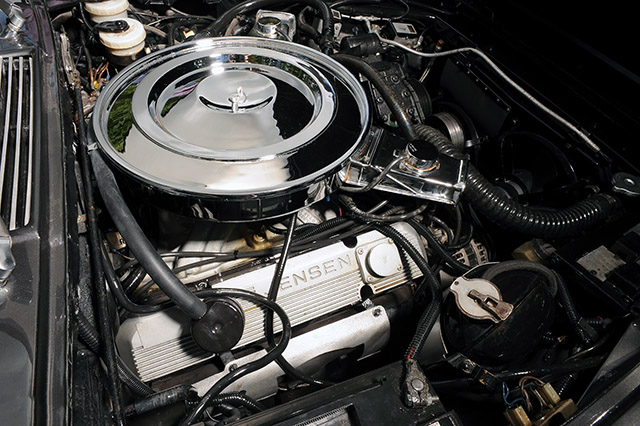
Engine accessibility is less daunting with the carburettor air cleaner removed.
The handbrake is just capable of locking the back wheels with a two-handed pull, producing a maximum before locking of 0.35g. It did not shine on the test hills, just holding on 1-in-4 if one held the lever pulled up beyond the final ratchet position.
Driving position and controls
In most respects the Jensen is a comfortable and convenient car to drive. There is just enough leg room for the majority of drivers, with space for the left foot to rest on the organ-pedal dip-switch when not used for left-foot braking. People who like to left-foot brake will wish that the dip- switch was on a stalk, not the floor, for obvious reasons. The steering wheel can be adjusted fore-and-aft over a useful range, but not for rake.
Seat adjustment is easily achieved, thanks to a wide release bar, and a slide which is spring-loaded forwards. To the right of the rev-counter is combined handbrake, pad- wear, and hydraulic-fluid-level warning lamp mounted in a rocker switch, which enables one to check that the bulb is functioning. Beyond that is the somewhat old-fashioned combined two-speed wiper and wash switch, which is not awkward to get at, though we would prefer a stalk switch beside the steering column at fingertip reach. The wipers, incidentally, are the Lucas type which do a sort of double-take when switched off. There is no hesitation or flick wipe provision. The single stalk controls signalling and flashing only.
One has no trouble finding the ignition – cum – steering lock, which faces one and has no awkward additional locks to release before you pull the key out. The speedometer and rev- counter are straight in front of the driver, with an old- fashioned trip zero, easily reached. To the left, all except the clock angled towards the driver, are the subsidiary instruments – temperature, oil pressure, fuel, and voltmeter. On the centre console are switches for foglamps, the fuel filler flap (working only when the ignition is off), town and country horn selector, hazard flashers, power roof raising or lowering, parking lamps, and lamps proper.
Each side of the selector lever are the electric window switches, which raise or lower the side glasses pleasingly fast, though a little noisily; the glasses however will not wind down completely into the door. Just in front of the driver’s door lock is a switch which saves one leaning across to lock the passenger’s door; a solenoid device, it works quietly. The boot-lid has no external release, but a remote handle in the driver’s door jamb, with a separate key to lock it; pulling the lever allows the boot-lid to rise on its counterbalance springs.
Heating and ventilation is dependent on a combined heating and air-conditioning cooling unit, which works best on either of the two fan speed settings rather than on ram air flow, of which there is too little. The slow speed setting is fairly quiet, yet adequate for most purposes once one has achieved the state one wants; the high speed is noisy but pretty effective. You can also with the same switch close the car to incoming air, which is welcome in unpleasant atmospheres, Between the two rotary switches is the compressor isolating switch, marked A/C (switched off for the performance-testing runs). The left-hand rotary switch selects temperature and distribution of air-flow, having five basic positions, defrost, cold, cool, warm and hot. In cold conditions the arrangement works satisfactorily, giving as much hot air as one wishes, with tolerable heat variation; the same applies if one wishes to cool the interior on a hot day, although every time that we used the cool setting, we noted an unpleasant smell from the air-conditioning. On average English autumn days when one wants a little flow of cool (not cold) air, we found it difficult to achieve that, in spite of the four generous facia vents. One small disadvantage of the flexible back window in the hood is, of course, that it cannot be fitted with any form of heater, so that it tends to mist up sometimes.
Since rear vision anywhere other than directly aft with the hood up is bad, one has to be very careful of Y junctions, trying to treat them like a van driver, approaching as nearly at right angles to the road joined as possible. Front and direct side vision is quite good, with no great blind spots even in rain, since the wiper arcs are satisfactory. The same cannot be said of side vision for anyone in either of the two back seats, who are somewhat blinkered unless they lean forward, which the careful – and very comfortable – shaping of the seats does not encourage one to do.
Living with the Interceptor Convertible III
Back seat passengers declared themselves pleased with the way they were held in place sideways by the cup-like recesses of the rear squab. If adult passengers are carried in the back it is necessary for the front seats to be adjusted forwards noticeably – to the slight discomfort of any tall driver and the insecurity of a front I passenger of more than slim figure, who could not buckle the seat belt, since it was not long enough on the test car used here.
As with most open cars, the Interceptor convertible comes into its own with the hood down. Lowering the top is simple enough initially – just release the two hood rail clamps, unzip the back, window and fold that on to the rear shelf, and. press the hood switch. The top then slowly winds back, with a pause in mid-stride, folding on to rather than into the back, the rear quarter windows then tilting backwards into the side if one continues to work the switch the windows can be left up if wished.
The not-so-convenient part of the operation is fitting the hood cover, for which no power is available other than your own weight, which may be needed to compress the hood frame enough to allow all of the numerous press studs on the cover to be done up. As mentioned before, the hood sits on top of the back, and not in a well, so that to some eyes it does not look tidy or neat. One can see over it in the inside mirror, however, and of course vision generally is vastly improved. There are various safety dropout switches to prevent overloading, which can be reset; they live in a panel in front of the driver under the dashboard.
{gallery}Jensen-Interceptor-MkIII-Convertible{/gallery}
We were surprised by the doors, which lack enough restraint in the door-holding straps; even on a slight camber, they will not hold their door open. When one shuts the driver’s door, there is a tendency for its ingenious American-style internally adjustable mirror to lose its setting. There are releases to allow the seat backs to be pushed out of the way of rear passengers – one release on either side of each seat. Their position at the base of the back means that one needs two hands to move the seat; also it is kinder if the driver or front passenger moves the back for anyone behind who wants to get out, since it is a big stretch forward from the back seat to release either lever.
A pleasantly thoughtful feature is the thermal delay switch for the four courtesy lamps. As on the Rolls-Royce Silver Shadow, the lamps do not extinguish themselves immediately one shuts both doors, so that you have light to don seat belts and find the ignition keyhole and so on. Another item that works when everything is supposedly off, is the pair of radiator electric fans, They will switch on and run for a little while after one has got out of the car and locked up, dealing with the heat that soaks out of the cooling engine. Their sudden whirr – one can feel them as a vibration in the steering wheel and floor inside the car incidentally – and the brilliantly lit interior both evident in a car which you have clearly already left prompts thoughtful bystanders to suggest that you have forgotten to switch off.
Another thoughtful point, once not so unfamiliar, is the provision of a battery charging socket on the passenger’s side, complete with plug. Ground clearance is adequate, the silencers being the lowest point and therefore having small skid-plates welded underneath. Boot space is fairly generous, though not quite as big as one might wish on some occasions. The nicely produced handbook provides an unusually thorough amount of information for the owner-driver on how to look after the car himself. The tool kit is quite comprehensive too, with various screwdrivers, three open-ended AF spanners, an adjustable spanner, a pair of pliers and a tyre pressure gauge. There is also a jack, wheel-brace, plug spanner and a pair of spare fan belts, all stored separately. The test car was fitted with a Radiomobile cartridge player/radio whose performance was spoiled by unduly resonant door-mountings for the front speakers. The Philips RN 712 cassette machine is also offered. Smaller cassettes would more easily be stored in the Jensen, which has only a limited amount of oddment space – a quite useful centre locker, and a much smaller one in the dashboard.
Remembering its price, and the company it is therefore among, one must be strict about the Jensen Interceptor Convertible. There are points which we have felt deserve criticism, but it must be stressed that for the man with a comfortable-enough wallet (both to buy it and to pay the fuel bill), it is a highly enjoyable car. We certainly enjoyed driving it – and, even remembering the price, it has very little competition.
Jensen Interceptor and FF Club
PRICES 1974
Basic £8,276.00
Special Car Tax £689.67
VAT £717.25
Total (in QB) £9,682.92
FRONT ENGINE, REAR-WHEEL DRIVE
| Car | 1974 Jensen Interceptor MkIII Convertible 7.2 |
|
Made in |
GB |
|
ENGINE Cylinders Main bearings Cooling system Bore Stroke Displacement Valve gear Compression ratio Carburettors Fuel pump Oil filter Max. power Max. torque |
Chrysler 8, in 90 deg vee 5 Water; pump, thermostat and electric fans 109.72mm (4.32in.) 95.25mm (3.75in.) 7.212 c.c. (440 cu. in.) Overhead, hydraulic tappets 8.2 to 1. Min. octane rating: 91RM One Carter four choke Carter mechanical Full flow, renewable element 280 bhp (net) at 4,800 rpm 380 lb. ft. (net) at 3,200 rpm |
|
TRANSMISSION Gearbox Gear ratios
Final drive Mph at 1,000 rpm in top gear |
Chrysler Torqueflite 3-speed automatic epicyclic with torque converter Top (Auto) 1.0-2.0 Inter 1.45-2.90 Low 2.45-4.90 Reverse 2.2-4.4 Salisbury hypoid bevel with Powr-Lok differential 24.8 |
|
CHASSIS and BODY Construction |
Steel body welded to tubular steel frame |
|
SUSPENSION Front Rear |
Independent; coil springs, double wishbones, telescopic dampers, antiroll bar Live axle; half-elliptic leaf springs. Panhard rod, telescopic dampers |
|
STEERING Type Wheel diameter |
Adwest rack and pinion, with power assistance 15in. |
|
BRAKES Make and type Servo Dimensions
Swept area |
Girling ventilated discs front and rear. Divided hydraulic circuits Girling vacuum F, 10.75in. dia. R, 10.75in. dia. F, 208.5 sq. in., R, 208.5 sq. in. Total 417 sq. in. (216 sq. in./ ton laden) |
|
WHEELS Type Tyres – make – type – size |
Cast aluminium alloy 6.5in. wide rim Dunlop, Radial ply tubed ER70VR 15in. |
|
EQUIPMENT Battery Alternator Headlamps Reversing lamp Electric fuses Screen wipers Screen washer Interior heater Heated backlight Safety belts Interior trim Floor covering Jack Jacking points Windscreen Underbody protection |
12 volt 66 Ah. 60 amp a.c. Lucas 4-lamp 110/220 watt (total) Standard 12 + 10 in-line Two-speed, self parking Standard electric Standard, air conditioning Not applicable Standard, inertia reel Leather seats, pvc headlining Carpet Bevel lift screw pillar Two each side under sills Laminated Bitumastic compound on surfaces exposed to road |
|
MAINTENANCE Fuel tank Cooling system Engine sump Gearbox Final drive Grease Valve clearance Ignition timing Spark plug Compression pressure Tyre pressures Max. payload |
20 Imp. gallons (91 litres) 32 pints (inc. heater) 8.5 pints (4.7 litres) SAE 20W/50. Change oil every 8,000 miles 17 pints. ATF type A. No change 3 pints. Shell l.s.d. oil S6721A Change every 8,000 miles 4 points every 4,000 miles Hydraulic (non-adjustable) 10 deg. BTDC (static) Type: Champion J11Y. Gap 0.035in. 100 psi. F 28; R, 32 psi (normal driving) F, 36; R, 40 psi (over 110 mph) 800lb (363kg) |





